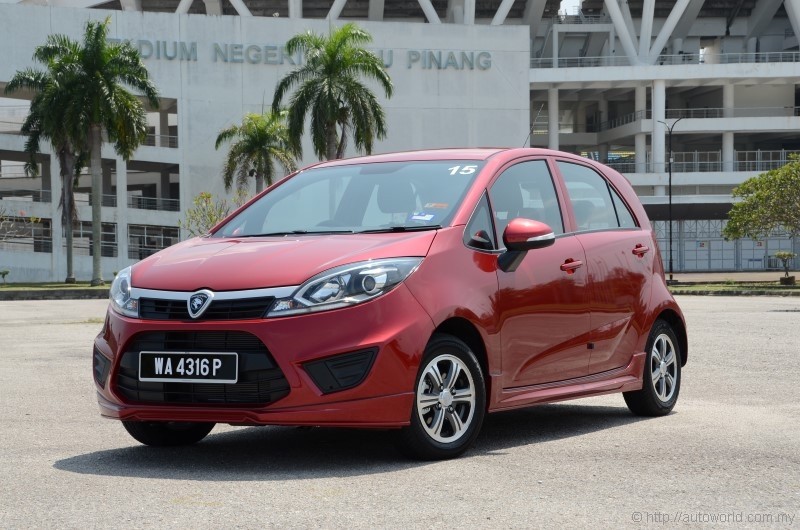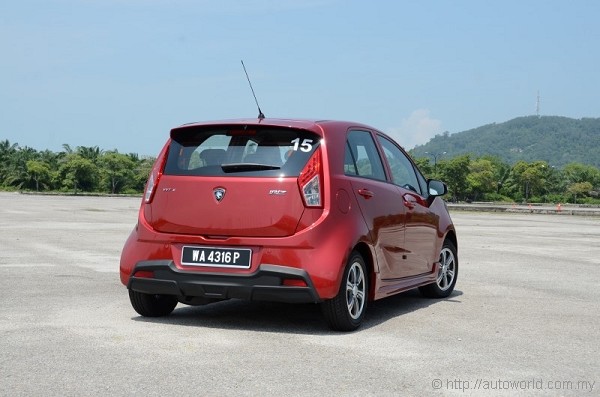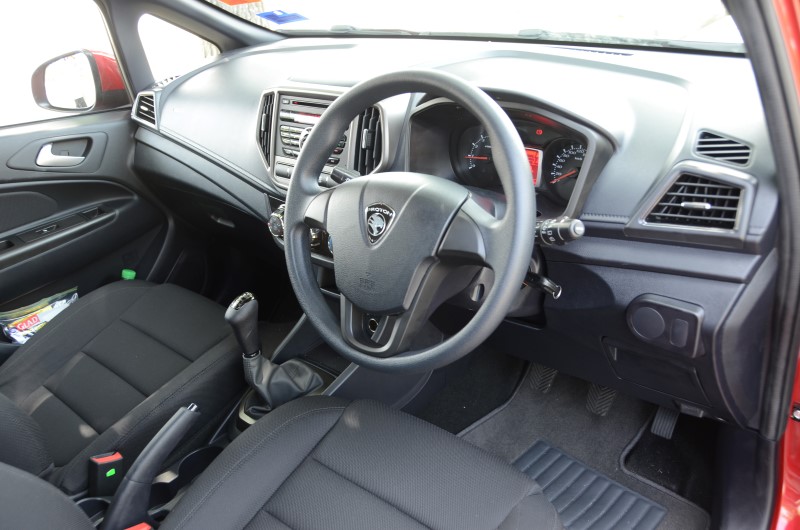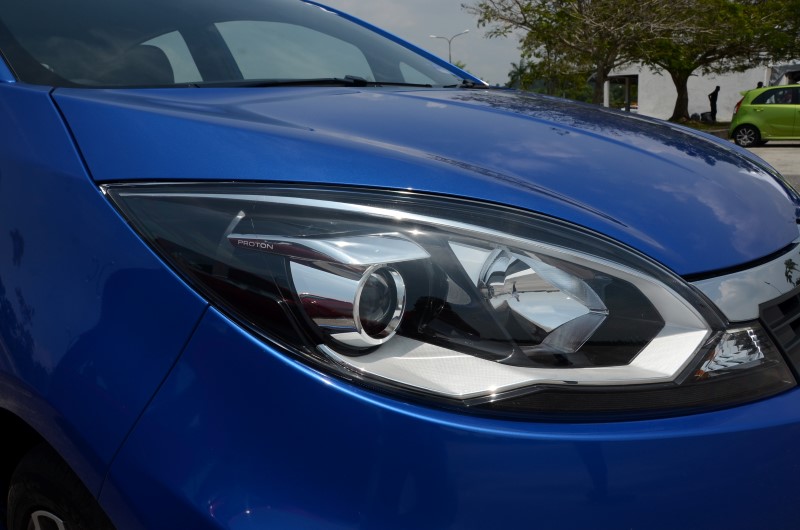Proton Iriz – Top of The Class Compact, Road Test
When automakers design a car for the mass market, especially a compact, the essentials are size and practicality, with retail price to be maintained as low as possible – the result is inevitably a basic car without frills which one can use as a daily run-about. This is exactly what one would expect from Proton, but the Iriz, being the latecomer, seems to be designed to outdo all the rest, coming with top-of-the-class features like ESC (Electronic Stability Control) and Traction Control System (TCS), in addition to ABS, BA (Brake Assist), and Hill-Hold Assist throughout the entire variant range, and even six airbags for the top models. With a price range from RM42k to RM62k through eight variants and two transmission options (5-speed manual and CVT), there is a wide choice available.
Driving the Iriz
With a high tech body that incorporates hot press forming, and reinforced parts in the right places, the Proton Iriz is a super rigid car that lends itself to good handling characteristics, and the Proton people, with lots of experience from Lotus Engineering, have managed to put together a package that makes the Iriz surprisingly stable at high speeds and highly manoeuvrable through corners.
We took part in a media drive of the Proton Iriz that saw us take it on a ‘high speed’ economy drive form Shah Alam to Ipoh, and then drive it to Penang and back; the event also included an ‘agility test’ at Batu Kawan stadium to check out how the ESC and TCS actually help the Iriz stay on the road under extreme conditions. With that test sequence, we also established that the Iriz is probably the safest car in its category.
The Fuel Economy Test
The first part of the drive was an economy test that started from the exit of Proton’s Centre of Excellence (COE) in Shah Alam to the Petronas station in Gopeng, Perak. The total distance was 185 kilometres, and although more than 90 percent of it was highway driving, the first fifteen or so kilometres and the last seven kilometres were through heavy traffic.
When I arrived at the COE, one of the first people I met was Uncle Chips Yap, veteran motoring journalist from the online Motor Trader portal, who told me that there would be a fuel economy run as part of the drive, and unabashedly told me that he had put my name down as his drive partner, and that he had selected the 1.3 manual for us. According to the list of cars, numbers 01 to 10 were the 1.6 litre models, and being early bird, Uncle Chips was allocated car number 11.
After a short briefing by the management, during which we were told the route distance, the shocker came when we were told that there the total allocated time was two hours, and the penalty for any arrival after the stipulated two hours would be subject to a penalty of 0.3 litres per 100 kilometres added to the overall fuel consumption for every 5 minute block of lateness. Based on the distance and allocated time, we needed an average speed of 92.5 kilometres per hour for the entire run. The first car was flagged off at 9.45 am, and this was deemed the official start time. Being car 11, I estimated we lost about 5 minutes at the start waiting for our turn. This meant that we would have to make up this time on the run by speeding up above the 92.5 kilometre per hour average. I took the first stint of driving – the air-conditioner was turned on, with the temperature set around midway, and the controls were sealed.
The moment we left COE, we were immediately stuck for another 5 minutes at the first traffic light where we had to make a U-turn under the flyover. Traffic was heavy, and it was not possible to hit the required average speed. In order to get to Gopeng on time, I had to keep tabs on the remaining distance and remaining time to constantly adjust my road speed – by the time we got through the traffic and things stabilized on the North South highway near Rawang, I realized that we had to drive at around 110 km/h just to get there on time.
The rules stipulated a compulsory driver change at a rest stop around mid-point between the start and end, and we complied. Somewhere near the end, we found to our horror that we were going to be late, and Uncle Chips had to speed up. We arrived six minutes late, and based on our actual consumption of 6.5 litres per 100 kilometres, 0.6 litres was added to our fuel consumption figure, bringing our result to 7.1 litres per 100 kilometres. It was enough to win our category – the next best was another media team that achieved 5.9 litres per 100 kilometres, but were slapped with a 1.5 litre penalty, making it 7.4 litres per 100 kilometres. For us, it was quite a strange feeling to be on an ‘economy’ run, yet having to overtake normal road cars. One thing is for certain, though – the figures we got are ‘real world’ figures, not only achievable, but can be bettered by anyone with a mind to drive ‘normally’, but with a light foot on the throttle.
Next, it was a drive to Ipoh for lunch and a continuation of the drive to Penang after that. This time we changed to a 1.6 with a CVT. The next day, we drove to Batu Kawan Stadium, where we put the Iriz through an ‘Elk’ (or perhaps for Malaysia it should be a Kerbau test), to check out the agility of the Iriz in an emergency accident avoidance situation, before heading back to Shah Alam.
Handling & Agility
Ride and handling has always been a strong point of Proton, and in the case of the Iriz, Proton again has managed to come out with a winner. Using hot press parts, and right reinforcements in the right places, the Iriz has an extremely rigid, perhaps over-engineered body, and together with knowledge gained from Lotus, the Iriz corners very well, and on one stretch without traffic, I was actually amazed at the superb straight-line stability and cross-wind stability at high speeds of up to 170 km/h.
It is again the same technology that makes the Iriz very agile through twists and turns, making it a very fun car to drive. With a good chassis and a good engine, the Iriz has the potential to be the equivalent of the Vauxhall Nova of the 1980’s as the budding rally driver’s car. (Colin McRae, world rally champion, started his early years in a Vauxhall Nova). The manual transmission model with the 1.6 litre engine will definitely be a hit with the young drivers.
All the Iriz models throughout the range feature ESC (Electronic Stability Control) and Traction Control System (TCS), and puts the Iriz at the top of the heap in terms of active safety. Personally, I think that perhaps these expensive features could be reserved for the top-of-the-line variants, making available a base model at an even more affordable price.
Fit and Finish
In terms of build quality, fit and finish, the Iriz is Proton’s best car yet. It seems I have been saying the same thing for the Preve, Suprima S, and now the Iriz – it happens to be true though – I can see that Proton are trying very hard to make a better car each time. Fit and finish is excellent, and the quality of materials is improving each time.
Engine and Transmission
The Iriz features a re-worked engine which basically incorporates a new cylinder-head design that comes with variable valve timing for the intake cam, and new cam profiles. The result is an engine that delivers the same horsepower as the previous engine, but with torque improvements and power coming in earlier. Translated to the road, it means that you will get better ‘pulling’ power from an early RPM than before – there is substantial improvement in drivability, and overall fuel consumption is improved as a result. The new engine is a definite improvement over the previous one.
I like the manual transmission 1.3 model, and look forward to trying out the 1.6 manual when it is made available. I am still not a fan of CVT’s in general, although I do recognise that they are good for fuel consumption. The CVT in the Iriz has seen some re-work, and I understand that there is ongoing development in that area. The CVT in the Iriz is a little quieter than in the previous Proton models, and appears to be smoother, with a lower degree of resonance, perhaps due to the more compact and rigid frame and the way the mounting points are positioned.
Overall Impression
The Proton Iriz leaves the competition far behind – it is a great car with great handling, and definitely raises the bar for cars not only for cars in its class but beyond as well. With manual and CVT options, it will appeal to a larger spectrum of people. What remains to be seen is if the Malaysian motoring public will cast aside all the old prejudices against the brand and give this car its due.




















































